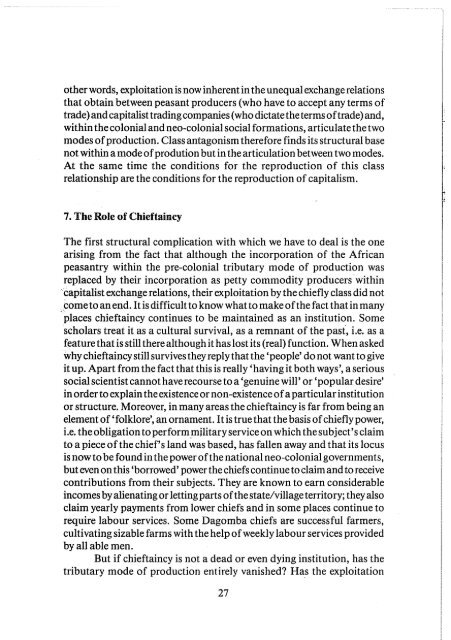Create successful ePaper yourself
Turn your PDF publications into a flip-book with our unique Google optimized e-Paper software.
other words, exploitation is now inherent in the unequal exchange relations<br />
that obtain between peasant producers (who have to accept any terms of<br />
trade) and capitalist trading companies (who dictate the terms oftrade) and,<br />
within the colonial and neo-colonial social formations, articulate the two<br />
modes of production. Class antagonism therefore finds its structural base<br />
not within a mode of prodution but in the articulation between two modes.<br />
At the same time the conditions for the reproduction of this class<br />
relationship are the conditions for the reproduction of capitalism.<br />
7. The Role of Chieftaincy<br />
The first structural complication with which we have to deal is the one<br />
arising from the fact that although the incorporation of the African<br />
peasantry within the pre-colonial tributary mode of production was<br />
replaced by their incorporation as petty commodity producers within<br />
capitalist exchange relations, their exploitation by the chiefly class did not<br />
come to an end. It is difficult to know what to make ofthe fact that in many<br />
places chieftaincy continues to be maintained as an institution. Some<br />
scholars treat it as a cultural survival, as a remnant of the past, i.e. as a<br />
feature that is still there although it has lost its (real) function. When asked<br />
why chieftaincy still survives they reply that the 'people' do not want to give<br />
it up. Apart from the fact that this is really 'having it both ways', a serious<br />
social scientist cannot have recourse to a 'genuine will' or 'popular desire'<br />
in order to explain the existence or non-existence of a particular institution<br />
or structure. Moreover, in many areas the chieftaincy is far from being an<br />
element of 'folklore', an ornament. It is true that the basis of chiefly power,<br />
i.e. the obligation to perform military service on which the subject's claim<br />
to a piece of the chief's land was based, has fallen away and that its locus<br />
is now to be found in the power ofthe national neo-colonial governments,<br />
but even on this 'borrowed' power the chiefs continue to claim and to receive<br />
contributions from their subjects. They are known to earn considerable<br />
incomes by alienating or letting parts ofthe state/village territory; they also<br />
claim yearly payments from lower chiefs and in some places continue to<br />
require labour services. Some Dagomba chiefs are successful farmers,<br />
cultivating sizable farms with the help of weekly labour services provided<br />
by all able men.<br />
But if chieftaincy is not a dead or even dying institution, has the<br />
tributary mode of production entirely vanished? Has the exploitation<br />
27
















